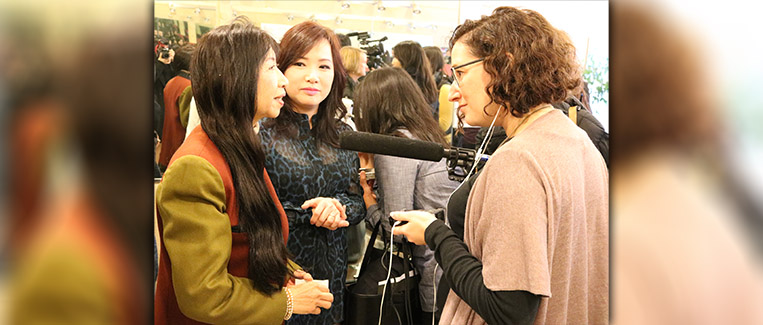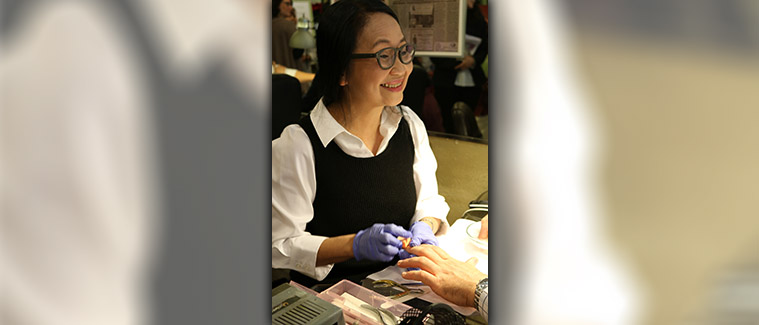The U.S. Environmental Protection Agency recently awarded a $120,000 grant to an East Bay health clinic working to address a major hazard faced by nail salon workers in the Bay Area and beyond-long-term exposure to harmful chemicals.

Oakland’s Asian Health Services, the recipient of a recent EPA grant, has worked with nail salons on a set of best practices designed to prevent exposure to harmful chemicals for salon workers. Photo courtesy of EPA
By Bill Picture
Published: January, 2017
The U.S. Environmental Protection Agency recently awarded a $120,000 grant to an East Bay health clinic working to address a major hazard faced by nail salon workers in the Bay Area and beyond—long-term exposure to harmful chemicals. Nail industry estimates show that nearly half of salon workers are of Vietnamese descent. In California, Vietnamese-Americans make up 80 percent of the nail salon workforce.
Oakland’s Asian Health Services (AHS), the recipient of the EPA grant, was one of nearly two dozen public health and environmental health entities that joined together in 2005 to create the California Healthy Nail Salon Collaborative (CHNSC). Since then, the group has been working to educate nail salon workers and owners about the serious health risks associated with chemical exposure, find ways to mitigate those risks, and enact programs that help ensure the safety of the nail salon workforce.
Toluene, a compound found in standard polishes, is just one of the harmful nail product additives to which the employees of traditional nail salons are exposed each day. Acrylic nails contain the most toxic compounds. Persons exposed to these chemicals for long periods—nail salon employees regularly work shifts of eight-plus hours, and a seven-day workweek isn’t uncommon—experience a wide range of ailments including asthma, dermatitis, memory loss, neurological disorders and possibly even cancer.
Of particular concern to CHNSC partners are the higher-than-normal rates of reproductive problems among female nail salon workers. Significantly more than half of the country’s nail salon workforce is female, according to industry studies. “Think about how close the nail salon workers are to your hands and feet,” said EPA Environmental Justice Coordinator Deldi Reyes. “Think about how many clients they service in a week, and all of those chemicals they’re breathing in.”
Nail salon workers have dangerous gaps in federal product-safety policies to thank for the continued use of such harmful chemicals by nail product manufacturers even after they’ve been shown to be toxic, said AHS Planning and Development Director Julia Liou. “There is no independent entity conducting pre-market safety studies of nail care products,” she said. “That’s the case with personal care products in general. In so many ways, salon workers are like the canaries in the coal mine.”
Helping salon owners help themselves and their employees
From the efforts of the collaborative comes AHS’s Healthy Nail Salon program, which allows a nail salon to be recognized as a “healthy nail salon” by voluntarily complying with nine workplace health and safety best practices. To date, more than 40 nail salons have participated.
“It’s a combination of using safer polishes, polish removers and thinners, ensuring proper ventilation, using protective equipment such as nitrile gloves, and ensuring workers are property trained,” Liou said.
With established ties to the Bay Area’s underserved Asian refugee and immigrant populations, AHS has a solid handle on tailoring a message to overcome the cultural and language barriers standing in the way of many agencies’ outreach efforts.
The biggest challenge, said EPA Environmental Justice Coordinator Deldi Reyes, has been convincing nail salon owners to invest in improvements that they fear might put them in the red. “They’re small businesses, after all,” Reyes said.
Nontoxic nail products cost a bit more than standard products, and upgrading a salon’s ventilation system requires an out-of-pocket investment that many salon owners simply can’t afford. The EPA money is intended to help more nail salon owners do the right thing. AHS has partnered with two lenders, Working Solutions and Opportunity Fund, to pilot a microloan program that lends money for the improvements required in order to be recognized as a healthy nail salon.
“This is a pioneering approach towards establishing a business model for this industry, where the return-on-investment is improved worker health and increased sustainability,” said Liou.
That return, she said, is not just hypothetical. Healthy nail salons throughout the state were surveyed, and most reported an increase in business after adopting the program’s best practices. It seems that as Californians work to green their lives, they appreciate an opportunity to patronize a business that shares their green values.
Further, meeting the requirements to be a healthy nail salon really does improve the lives of nail salon workers. Liou said that a pilot study conducted by the EPA Region 9, Cancer Prevention Institute of California and the San Francisco Department of the Environment showed that the air in healthy nail salons contained significantly lower levels of toluene and other toxic compounds than traditional nail salons.
“So it really does work,” said Reyes. “These businesses play a significant role in terms of the economic diversity of their communities. Protecting the health of workers also makes this a much more sustainable way for them to make a living.”

Nail salons adopting best practices have reported increases in business after implementation. Photo courtesy of EPA

